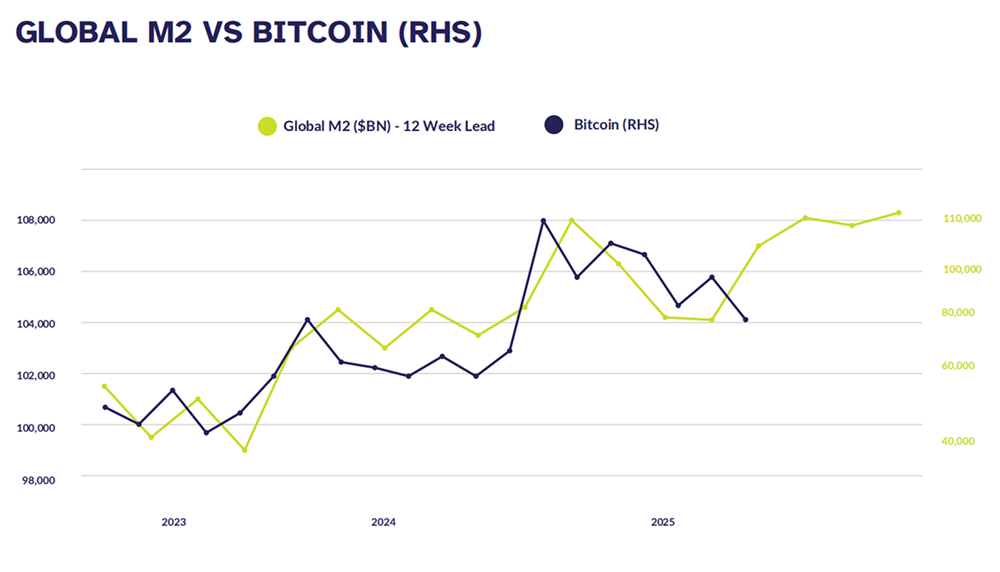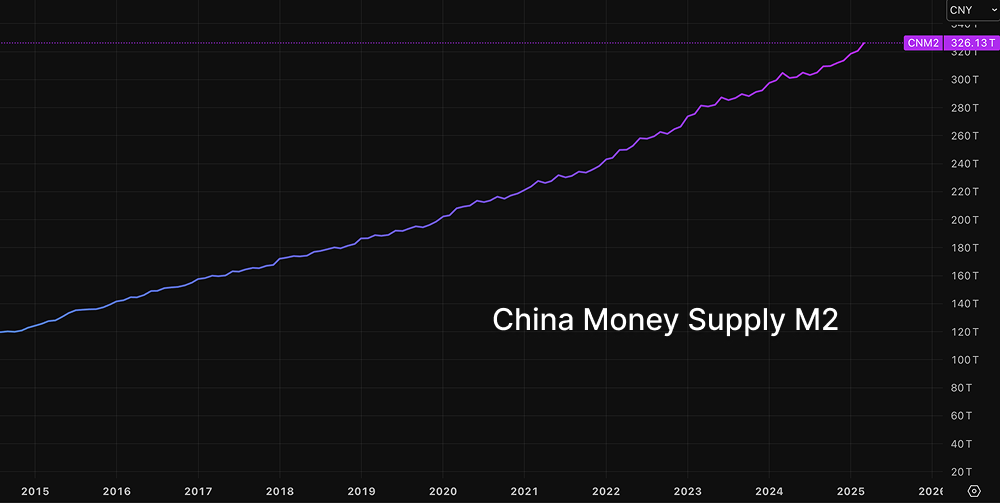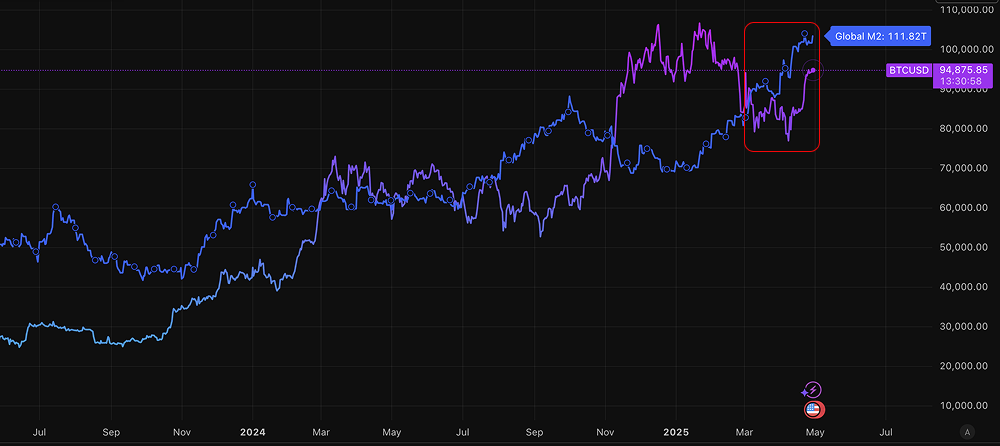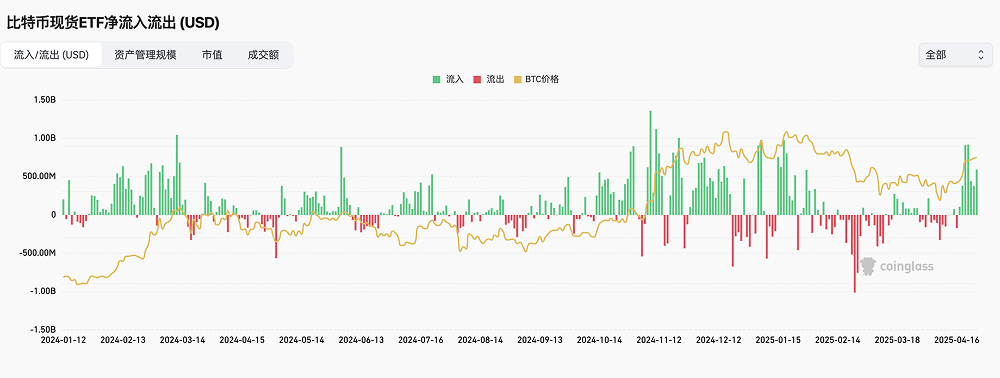Since April 2025, the cryptocurrency market has been searching for a new direction amidst fluctuating uncertainties, with Bitcoin's price rebounding from $78,000 to around $94,000, experiencing wide swings. Market sentiment is divided: some investors view this as a "consolidation period" before the next bull market, while others worry that the pullback from the $110,000 high in 2024 marks the end of the rebound momentum. Short-term noise—such as ETF fund flows, regulatory trends, and KOL statements—frequently makes headlines, but what truly drives Bitcoin's mid-term trend is global macro liquidity, particularly changes in the global M2 money supply. Recent data shows that global M2 has surged to $108 trillion, and it is expected to further expand to $127 trillion in the coming quarters. Can this wave of liquidity bring a structural rebound for Bitcoin?
M2 and Bitcoin: Insights from Historical Patterns
The global M2 money supply—which includes cash, deposits, and short-term liquid assets—is a core indicator of global liquidity. Historical data indicates that the expansion and contraction of M2 often precede significant turning points in Bitcoin prices. At the end of 2024, a brief contraction in global M2 led to a sharp drop in Bitcoin's price from $110,000 to $78,000, a nearly 30% decline. A similar scenario occurred in 2022 when a slowdown in M2 growth caused Bitcoin to fall from $69,000 to a low of $16,000. Conversely, the rebound in M2 in 2023 propelled Bitcoin from $20,000 to $40,000. These cases reveal a pattern: M2 growth typically provides a "tailwind" for Bitcoin prices, while contraction brings "headwinds."
Data from April 2025 further validates this correlation. Analysis on X indicates that there is a lag effect of 60 to 108 days between Bitcoin prices and global M2. For instance, @ColinTCrypto mentioned in a post on April 22 that global M2 has been hitting new highs since the beginning of 2025, with the current upward trend continuing for three months and expected to last until August. This aligns with Bitcoin's recent stabilization around $88,000. More importantly, the growth of M2 not only affects Bitcoin but is also highly correlated with the performance of inflation-hedging assets like gold, reinforcing its credibility as a macro trend indicator.

Current Trend: The "New High" Signal of Global M2
According to the latest data, as of April 2025, global M2 has reached $108 trillion, an increase of about 5% from the end of 2024. Among them, China's M2 has surpassed 326 trillion yuan (approximately $46 trillion), becoming a significant driver of global liquidity expansion. The market expects that in the coming quarters, global M2 is likely to further increase to $127 trillion, with a growth rate potentially exceeding 15%. This forecast is set against the backdrop of policy shifts from central banks: the Federal Reserve is approaching a rate cut window, while the Bank of Japan and the European Central Bank maintain an accommodative tone, and emerging market countries are also increasing monetary supply to cope with economic pressures.

What does the continued expansion of M2 mean for Bitcoin? Bitcoin's fixed supply (21 million) gives it a natural advantage in an environment of excess liquidity. When inflation expectations rise, institutional investors tend to view Bitcoin as "digital gold" to hedge against currency devaluation risks. Analyst @biteshizhe on X points out that the current alignment between M2 growth and Bitcoin price trends has increased again, and historically, this indicator has accurately predicted Bitcoin's mid-term trends multiple times. Coupled with market news from April 28, 2025, Bitcoin has begun to rise slightly against the backdrop of improving global risk sentiment, reflecting the initial effects of liquidity expansion.

The Combined Effect of Central Bank Policies and ETF Regulation
The liquidity policies of central banks are the direct drivers of M2 growth. Since April 2025, expectations for interest rate cuts from the Federal Reserve have been rising, with the market anticipating the start of a rate cut cycle as early as June. Meanwhile, the Bank of Japan continues to maintain an ultra-loose monetary policy, and the European Central Bank is also releasing liquidity in a low-interest-rate environment. These policies collectively drive the rise in global M2, providing a fertile ground for capital inflows into high-risk assets like Bitcoin.
Additionally, the relaxation of ETF regulations has further amplified the transmission effect of liquidity. On March 28, 2025, the Federal Deposit Insurance Corporation (FDIC) in the United States issued new regulations allowing regulated banks to engage in cryptocurrency-related activities without prior approval. This policy is seen as a "countdown" signal for banks entering the crypto market, potentially attracting more institutional funds into Bitcoin ETFs.

Risks and Outlook: Certainty and Uncertainty of Rebound
Although the expansion of M2 provides structural benefits for Bitcoin, risks cannot be ignored. First, global economic uncertainties may disrupt the transmission of liquidity. Data from April 2025 shows that geopolitical tensions and unclear tariff policies are exacerbating market volatility, which may lead to short-term capital flowing into safe-haven assets rather than Bitcoin. Secondly, the lagging response of Bitcoin prices means that the current growth of M2 may gradually manifest effects in the next 2 to 3 months, requiring investors to remain patient.
Overall, the continued expansion of global M2 provides a solid foundation for Bitcoin's mid-term rebound. It is expected that in the third quarter of 2025, as liquidity is further released, Bitcoin is likely to challenge the $100,000 mark and even return to the $110,000 high. However, short-term volatility will still be influenced by ETF fund flows, regulatory dynamics, and KOL sentiment. Investors should closely monitor M2 growth rates, central bank policy trends, and the allocation rhythm of institutional funds to seize opportunities in this wave of liquidity.
This article represents the author's personal views and does not reflect the stance or views of this platform. This article is for informational sharing only and does not constitute any investment advice to anyone.
Join our community to discuss this event
Official Telegram community: t.me/aicoincn
Chat room: Wealth Group
免责声明:本文章仅代表作者个人观点,不代表本平台的立场和观点。本文章仅供信息分享,不构成对任何人的任何投资建议。用户与作者之间的任何争议,与本平台无关。如网页中刊载的文章或图片涉及侵权,请提供相关的权利证明和身份证明发送邮件到support@aicoin.com,本平台相关工作人员将会进行核查。




